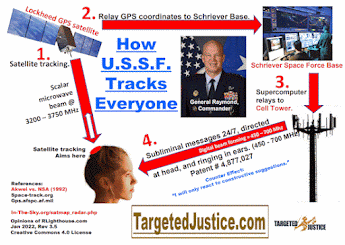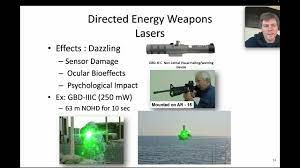Patent No. 5666105 Personal radiation hazard meter
Patent No. 5666105
Personal radiation hazard meter (Adler, et al., Sep 9, 1997)
Abstract
An electromagnetic radiation monitor for use in close proximity with the human body comprised of an electromagnetic radiation sensor for detecting hazardous radiation levels. The radiation monitor also includes means for shielding the sensor from electromagnetic interference caused by the human body. A single layer of a plurality of lossy materials arranged in a precise, predetermined mosaic pattern is used in conjunction with a shield to prevent interference due to unwanted reflections caused by the shield resulting in a wideband frequency response previously unachievable.
Notes:
Personal
radiation hazard meter. Filed March 1996, granted September 1997. Detects electromagnetic
radiation intensity levels. Does detect .01 milliwatts per centimeter squared
level. May be useful as part of detection system.
BACKGROUND
OF THE INVENTION
1. Field of the Invention
This invention relates to electromagnetic radiation detection devices. More
particularly, this invention relates to electromagnetic radiation detection
devices which may be worn by an individual to alert such an individual of harmful
levels of electromagnetic energy over a broadband of frequencies.
2. Description of Prior Art
The use of high power radio and microwave frequencies in the military, commercial
and consumer applications has grown substantially. The applications of high
power electromagnetic sources are numerous, including for example, radar, satellite
communication ground terminals, radio transmitting antennas and microwave ovens.
One problem with high power electromagnetic radiation is its potential harmful
effects on lining tissue. The American National Standards Institute have established
safety guidelines to prevent exposure to harmful levels of electromagnetic radiation.
Harmful levels of electromagnetic radiation may not be detected by an individual
until permanent damage results. Accordingly, a work place in the vicinity of
high power electromagnetic sources can be a dangerous environment. Therefore,
there is a need for a device which can sense and measure electromagnetic radiation
and provide an alert signal indicating harmful ambient levels. Furthermore,
because of the numerous applications of electromagnetic sources and the multitude
of frequencies generated, such electromagnetic radiation detection devices having
a broadband frequency performance are desirable.
Broadband electromagnetic radiation detection devices have been used in the
art for many years. For example, U.S. Pat. No. 3,931,573 assigned to the assignee
of the present invention, discloses a hand-held radiation detector. However,
hand-held radiation detectors may sometimes be cumbersome and inconvenient.
Therefore, radiation hazard meters which can be worn by an individual are both
practical and desirable.
When constructing a personal radiation hazard meter, electromagnetic interference
from a human body is a concern. It is known that interference in the form of
electromagnetic scattering results when electromagnetic radiation reflects off
the human body. Such scattered reflections interfere with the electromagnetic
radiation being detected by the radiation detector and introduce inaccuracies.
To minimize body interference, the radiation sensors of personal radiation hazard
meters require shielding of the electromagnetic radiation sensor from the user's
body. The shield, however, may produce its own source of interference due to
unwanted reflections.
The use of lossy material as a radiation absorber to absorb reflective radiation
is well known in the art. However, lossy material has an acceptable reflective
characteristic over a limited frequency range. Generally, the more highly absorbent
the lossy material is the smaller the useful frequency range it has. The relatively
large operational bandwidth of the monitor precludes the use of a single type
of lossy material. This property of lossy material suggests that the use of
multiple layers of lossy material having different absorption (and, accordingly,
reflective) characteristics would be most effective in eliminating reflective
interference from the conductive shield.
An example of this technique is shown in U.S. Pat. No. 5,168,265 (Aslan). A
less absorbent/reflective lossy material is disposed behind the radiation sensor,
then at least a second layer of more absorbent/reflective lossy material is
disposed behind the first layer and in front of the shield. The lamination of
lossy materials reduced body reflected radiation and lessened measurement errors
over the operational bandwidth of the monitor.
Although layering lossy materials has been tried what is desired is a body worn
microwave radiation monitor having a frequency response that is immune to body
reflected interference.
SUMMARY AND OBJECTS OF THE INVENTION
A personal radiation monitor is provided having the back of its radiation sensors
shielded to enable the meter to be worn on the human body without reflected
body interference. A single layer of different lossy materials arranged in a
mosaic is disposed between the shield and the sensor which effectively eliminates
reflective interference from the shield.
The object of this invention is to provide an improved personal radiation hazard
meter which has accurate broadband frequency performance characteristics.
It is another objective of this invention to provide an improved personal radiation
hazard meter which minimizes the effects of electromagnetic radiation interference
caused by a human body.
It is yet another object of this invention to provide an improved personal radiation
hazard meter which displays the power density of the electromagnetic radiation
being sensed and alarms the user whenever the radiation exceeds a user programmed
level.
It is another object of this invention to provide an improved personal radiation
hazard meter which may be used with an earphone to allow the user to work in
high noise environments.
Other objects and advantages of the personal radiation monitor will become apparent
to those skilled in the art after reading the detailed description of the preferred
embodiment.
DESCRIPTION
OF THE PREFERRED EMBODIMENT
The preferred embodiment will be described with reference to the drawing figures
where like numerals represent like elements throughout.
With reference to FIGS. 1-5, there is shown a radiation hazard meter 10 which
is to be used in close proximity to a human body. The meter 10 has a two-piece
housing 12 comprised of a front cover 14 and a containment 16. The back of the
monitor includes a clip 26, so that the monitor can be clipped to a user's belt
or clothing. The interior of the housing 12 is partitioned into lower and upper
chambers 28, 30 by an interior wall 32. The lower chamber 28 houses an antenna
assembly 34 which functions as the radiation sensor. The upper chamber 30 houses
the electronic processing circuitry 36 which is electrically coupled to sensor
34. The electronic processing circuitry 36 analyzes the radiation levels detected
by the antenna assembly 34. For example, see U.S. Pat. No. 3,931,573, and the
references cited therein which patents are incorporated herein by reference
as if fully set forth.
The electronic processing circuitry 36 is operatively associated with a light
emitting diode (LED) 38, an alphanumeric liquid-crystal display (LCD) 40, and
a speaker 42 associated with an earphone receptacle 44. The LED 38 continuously
flashes to alarm the user when the radiation sensor 34 detects electromagnetic
radiation which exceeds a user programmable pre-determined level. The radiation
hazard meter 10 also warns the user with speaker 42 producing an audible alert
signal either alone or through the earphone receptacle 44 to the user via an
earphone 45. In addition, the alphanumeric LCD display 40 also flashes when
the radiation hazard meter 10 alarms.
In the preferred embodiment, the electronic processing circuitry 36 is configured
to permit audioranging and multiple modes of measurement indication. The radiation
hazard meter 10 autoranges from 0.02 to 20.0 mW/cm.sup.2 and has a user programmable
alarm level setting between the ranges of 0.01 to 20.0 mW/cm.sup.2. A measurement
indication switch 46 enables the user to change the instantaneous power density
indicated on the LCD display 40 from milliwatts per centimeter squared or the
six minute average power density in milliwatts per centimeters squared, depending
on the switch setting.
The electronic processing circuitry 36 is powered by one or more lithium batteries
48 which are installed into the upper compartment via a battery hatch 50. An
on/off switch 52 controls the power supplied from the batteries 48 to the electronics
36.
To prevent undue interference with the performance of the electronic processing
circuitry 36, shielding is provided. In particular, a combination of layered
absorbent material and metallic shield are disposed in front of and below the
electronic processing circuitry 36. The circuitry shielding is comprised of
a first layer of a relatively low absorbent lossy material 54, a layer of relatively
high absorbent lossy material 56 and a thin layer of foil or conductive paint
58 behind the relatively high absorbent lossy material 56. The relatively low
absorbent layer of lossy material 54 is Eccosorb.RTM. LS-16, manufactured by
Emerson and Cuming, Inc. The relatively high absorbent layer of lossy material
56 is Eccosorb.RTM. FGM-40, also manufactured by Emerson and Cuming. The properties
of the lossy materials are set forth in Emerson and Cuming's Technical Bulletins
8-2-23 dated January, 1985 and 2-11 dated November, 1980 which are herein incorporated
by reference as if fully set forth.
Additional shielding in the form of conductive paint or foil 58 is provided
for the sides, partially shown for clarity in FIG. 4, of the electronic processing
circuitry 36. Further protection is provided below the electronic processing
circuitry 36 by absorber 59 mounted on the upper wall of the lower chamber 28.
Absorber 59 is a uniform layer of lossy material such as Eccosorb.RTM. FGM-40
or LS-26 manufactured by Emerson and Cuming. The interior of the upper portion
of the containment 16 is provided with a coating of metallic paint 61 which
provides shielding in back of the processing circuitry 33.
The radiation sensor assembly 34 comprises a dielectric panel 60. Mounted on
the front of the dielectric panel 60 are two mutually orthogonal sensor assemblies
62 which are coplanar with each other. As shown in FIG. 6, each sensor assembly
62 includes an array of thin film thermocouples 66, 68 formed on a substrate
69. Each thermocouple is composed of two dissimilar metals such as bismuth 66
and antimony 68 and are connected in series as set forth in U.S. Pat. No. 3,931,573.
Each thermocouple supporting substrate 69 is sandwiched between a pair of dielectric
covers 70 which are mounted on the panel 60. The dielectric covers 70 are made
of boron nitride chosen for the properties of high thermal stability and high
electrical resistance. The sensor assembly 34 absorbs and converts a portion
of the impinging radiation into heat. The heat is then converted thermoelectrically
into a dc voltage for processing, measurement and display.
A radiation window 72 is defined in the front of the sensor chamber 28 in the
housing. The window 72 is defined by a square array of pyramidal shapes 74 molded
on both sides of the housing cover 14. At high frequencies, this construction
tends to have a scattering effect on any reflected signal to inhibit reflections
back onto the antenna, covering a wide range of incident angles.
Since the radiation monitor is designed to be worn on a person's body, shielding
is desirable behind the radiation sensor assembly 34 to prevent interference
attributable to the user's body. Such shielding is provided in the form of a
layer of conductive paint and/or foil 76 disposed on the back wall of the sensor
chamber 28. No shielding is provided on the bottom or sides of the sensor chamber
28 since the effect of body interference from those angles is negligible.
Although the metallic shielding 76 serves to shield the sensor assembly from
reflected interference from the rear, it similarly causes radiation measured
from the front to be reflected back towards the sensor assembly 34. Such reflected
radiation affects the frequency response of the sensor resulting in measurement
inaccuracies across the operational bandwidth.
As shown in FIG. 7, in the preferred embodiment, a single layer mosaic of two
uniform lossy materials, Eccosorb.RTM. FGM-40 78 and Eccosorb.RTM. MF-190 79
both 3.2 mm thick, are mounted directly on the metallic shielding 76. The thermocouple
sensors 66 and 68 are disposed approximately 5.7 mm in front of the front surface
of the layer of lossy material 78 of which approximately 3.2 mm is an air gap
between the mounting panel 60 and the lossy material 78.
Two variations of the preferred embodiment vary the height of the lossy material
79 directly under each radiation sensor 62 as shown in FIGS. 7B and 7C. FIG.
7B shows the thickness of the low absorbent lossy material 79 less than the
thickness of the high absorbent lossy material 78. FIG. 7C shows the thickness
of the low absorbent lossy material 79 greater than the high absorbent lossy
material 78. Varying the thickness of the low absorbent lossy material acts
to tune and flatten the frequency response of the radiation sensor 62 assembly.
An alternative embodiment of the uniform lossy material mosaic is shown in FIG.
8. The low absorbent lossy material 79 is circular rather than a silhouette
of each radiation sensor 62 assembly. As shown in FIG. 8A, both types of lossy
material are the same thickness as previously discussed. As shown in FIGS. 8B
and 8C, the low absorbent lossy material is varied in thickness to similarly
tune the frequency response of the radiation sensors 62.
FIG. 9 illustrates the frequency response of the initial attempt utilizing a
single layer of lossy material in the radiation hazard monitor 10. As seen from
the graph, minimum and maximum responses varied about 6.5 dB across a frequency
band of 1 GHz to 18 Ghz.
In comparison, FIG. 10 shows the frequency response of the preferred embodiment.
As seen from the graph, the radiation hazard meter 10 exhibits a relatively
flat frequency response with less than 4.0 dB variation across a bandwidth of
1 GHz to 18 GHz. This is an improvement of 3.0 dB as compared to a single uniform
layer comprised of only one lossy material.
In operation, the radiation sensor 34 absorbs a portion of the electromagnetic
radiation which enters the sensing chamber 28 and generates a dc voltage that
is proportional to the energy of the electromagnetic radiation. The electromagnetic
radiation that travels past the radiation sensor 34 propagates through and is
partially absorbed by the lossy material 78 and converted to heat. Any radiation
which is not absorbed by the lossy material 78 reflects off the shield 76. The
reflected electromagnetic radiation travels in the reverse direction through
the lossy material 78 towards the radiation sensor 34. The round-trip propagation
through the lossy material 78 substantially reduces or eliminates the energy
of the reflected electromagnetic radiation. Although some of the radiation reflects
directly off the front of the lossy material 78, the result is the virtual elimination
of electromagnetic radiation scattering.
Although the invention has been described
in part by making detailed reference to certain specific embodiments, such details
are intended to be instructive rather than restrictive. It will be appreciated
by those skilled in the art that many variations may be made in the structure
and mode of operation without departing from the spirit and scope of the invention
as disclosed in the teachings herein.





Comments